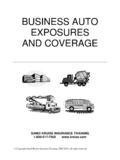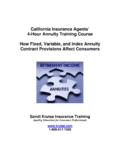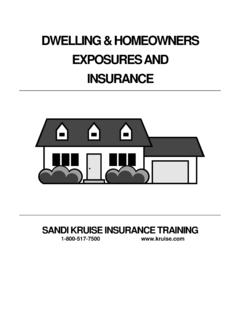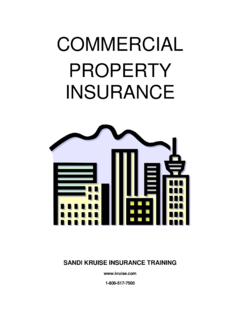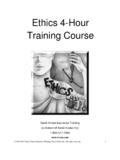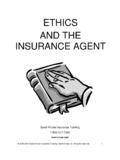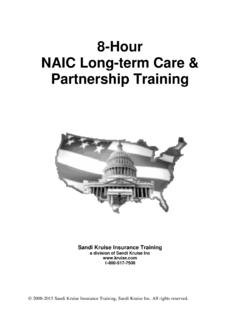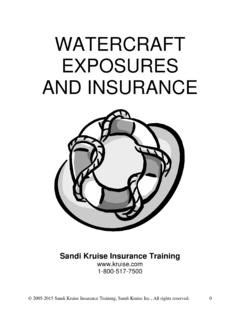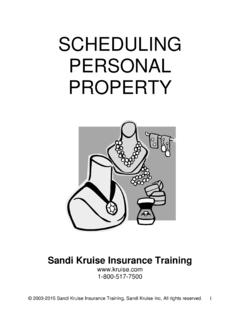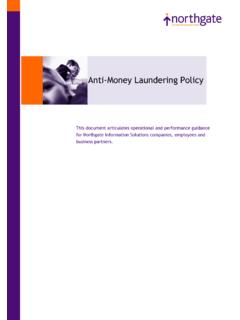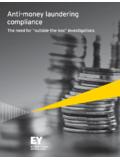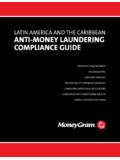Transcription of Anti-Money Laundering - 2015 Edition - Sandi …
1 Copyright 2007- 2015 Sandi Kruise Insurance Training, Sandi Kruise Inc, all rights reserved 1 Anti-Money Laundering 2015 Edition Continuing Education Course for Insurance Agents and Brokers Published by Sandi Kruise Insurance Training a division of Sandi Kruise Inc Copyright 2007- 2015 Sandi Kruise Insurance Training, Sandi Kruise Inc, all rights reserved 2 Table of Contents Anti-Money Laundering .. 5 Introduction .. 5 What Insurance Agents and Brokers Should Expect under the New Anti-Money Laundering Regulations for Insurance Companies .. 5 Terrorism and Criminal Activity .. 6 What is money Laundering and Terrorist Financing? .. 7 money Laundering .. 7 Terrorist financing .. 7 A Global Problem .. 8 Legal Requirements Adopted .. 8 Bank Secrecy Act of 1970 .. 9 money Laundering Control Act of 9 Additional Legislation .. 9 The USA PATRIOT Act .. 10 Currency and Monetary Instrument Transportation Report (CMIR) .. 10 Report of Foreign Bank and Financial Accounts (FBAR) .. 10 Funds Transfers and Transmittals.
2 10 Using the OFAC List .. 11 Penalties .. 11 Broker-Dealer Requirements .. 12 Customer Identification Programs (CIP) .. 12 Know Your Customer (KYC) .. 12 Customer Due Diligence (CDD) .. 13 money Laundering Indicators - Policyholder Characteristics and Behavior .. 15 Cash Premium Payments .. 16 Single Premium Life Insurance Contracts .. 16 Early Policy Redemption .. 16 Free Look Periods for Newly Issued Policies .. 16 Collusion of Customer Intermediary and/or Insurer Employee .. 17 High Commissions .. 17 Third Party Premium Payments .. 17 Risks Involved in International Transactions .. 17 Fraudulent Customers, Insurers, or Reinsurance Companies .. 17 A Known Criminal or Criminal Associate or Relative .. 18 Erratic or Abnormal Use of Policies .. 18 High Premiums Compared to Verifiable Income .. 18 Lack of Concern Over Charges or Costs .. 18 Undue Interest in Payout Options .. 18 Change of Beneficiary .. 18 High Profile money - Laundering Cases .. 19 Copyright 2007- 2015 Sandi Kruise Insurance Training, Sandi Kruise Inc, all rights reserved 3 Anti-Money Laundering Program and Suspicious Activity Reporting Requirements for Insurance Companies.
3 21 Resources Available to help an Insurance Company to establish an Adequate Program .. 21 FinCEN Final Rules .. 21 Anti-Money Laundering Program Requirement for Certain Insurance Companies .. 21 AML Program Requirements .. 22 Responsibilities of Agents and Brokers Under the New Rules .. 22 Customer 23 Customer Identification Program .. 23 Anti-Money Laundering General Requirements .. 24 Insurance companies required to perform a risk assessment .. 24 Risk-based compliance: Each institution is different .. 25 Methods of Payment .. 25 (1) A compliance officer who is responsible for ensuring that the program is implemented effectively.. 26 (2) Policies, procedures, and internal controls.. 27 (3) Ongoing training of appropriate persons concerning their responsibilities under the program.. 29 Training for Agents and Brokers .. 29 (4) Independent testing to monitor and maintain an adequate program.. 31 Testing the Effectiveness of the Anti-Money Laundering Program .. 31 Covered products.
4 32 Any Other Insurance Product with Features of Cash Value or Investment .. 33 Insurance Products that are not Covered Products Pursuant to the Rule .. 33 Definition of Insurance Company .. 33 The Final Rule Does Not Apply to All Insurance Companies .. 34 Agents and brokers not covered by final rules .. 35 Contractual Arrangements with Agents and Brokers .. 36 Suspicious Activity Reports Filing Requirement for Certain Insurance Companies . 37 All SAR reports are confidential .. 37 Suspicious Activity Reporting (SARs) General Requirements .. 38 Form 8300 Report of Cash Payments Over $10,000 Received in a Trade or Business .. 38 SAR Filing Thresholds .. 39 Suspicious Transactions Conducted Through Agents or Brokers .. 41 What to File .. 42 Where to File .. 42 When to File SAR .. 42 Exceptions .. 43 Retention of Records .. 43 Insurance Brokers and Agents are not Required to File Suspicious Activity Reports .. 44 Confidentiality & Safe Harbor .. 45 Information Regarding a Suspicious Activity Report May Not Be Disclosed.
5 46 An Insurance Company That Files a SAR Voluntarily Will Be Protected from Civil Liability46 Insurance Companies May Now Participate in Information Sharing Pursuant to the USA PATRIOT Act and Financial Crimes Enforcement Network Regulations .. 47 Joint Suspicious Activity Reports .. 47 Copyright 2007- 2015 Sandi Kruise Insurance Training, Sandi Kruise Inc, all rights reserved 4 Examining Authority & Compliance .. 47 Compliance .. 48 Requirement for Companies Registered with the SEC .. 48 How Suspicious Activity Involving Variable Insurance Products Funded by Separate Accounts that Meet Definition of a Mutual Fund be Reported .. 49 Copyright 2007- 2015 Sandi Kruise Insurance Training, Sandi Kruise Inc, all rights reserved 5 Anti-Money Laundering Continuing Education Course for Insurance Agents Introduction The September 11 attacks showed the terrible destruction and loss of life that money Laundering could make possible. As a result, Congress passed the USA PATRIOT Act, which greatly strengthens Anti-Money Laundering laws and places increased responsibility on financial institutions to detect and report signs of money Laundering .
6 This course is intended to provide agents and brokers with knowledge of money Laundering and terrorist financing and the ways in which the insurance industry might be used to engage in such activities. In addition, it provides an in-depth look at the requirements imposed by the Treasury Department regulations, as well as the means by which brokers and agents may be integrated into insurers AML programs. What Insurance Agents and Brokers Should Expect under the New Anti-Money Laundering Regulations for Insurance Companies Insurers and agents now have additional responsibilities related to Anti-Money Laundering and terrorist activities as a result of changes in the Bank Secrecy Act and the passing of the USA PATRIOT Act. This will be a new experience for the majority of those associated with the insurance industry. Agents and insurers have traditionally felt that they were immune from such activity. Today we realize that cash value life insurance and annuities products offer an excellent method of money Laundering .
7 Financial Crimes Enforcement Network (FinCEN), the U. S. Treasury s chief Anti-Money Laundering watchdog, in October 2005 announced that insurance companies would have to comply with the same laws already on the books for banks and broker dealers. While banks and broker dealers have long been subject to such regulations, insurance companies and other parts of the financial industry have remained relatively immune, until now. The USA PATRIOT Act includes provisions intended to prevent the financial services industry, including the insurance industry, from being used for money Laundering and terrorist financing by criminals and terrorists. Under two final rules announced by the Financial Crimes Enforcement Network (FinCEN), certain insurance companies are required to both establish Anti-Money Laundering (AML) programs and file Suspicious Activity Reports (SARS) on clients who exhibit behavior that warrants concern and government investigation.
8 Insurance companies subject to these rules must establish an Anti-Money Laundering program and start filing Suspicious Activity Reports 180 days after the date of the publication of the final rules in the Federal Register May 2, 2006. The final rules apply to insurance companies that issue or underwrite certain products that present a high degree of risk for money Laundering or the financing of terrorism or other illicit Copyright 2007- 2015 Sandi Kruise Insurance Training, Sandi Kruise Inc, all rights reserved 6activity. The types of contracts most vulnerable have cash values that can be easily accessed. The insurance products subject to these rules include: Permanent life insurance policies, other than group life insurance policies; Annuity contracts, other than group annuity contracts; Any other insurance products with features of cash value or investment features. At minimum, insurance companies subject to the rule requiring an Anti-Money Laundering program must establish a program that comprises four basic elements: A compliance officer who is responsible for ensuring that the program is implemented effectively; Written policies, procedures, and internal controls reasonably designed to control the risks of money Laundering , terrorist financing, and other financial crime associated with its business; Ongoing training of appropriate persons concerning their responsibilities under the program; and Independent testing to monitor and maintain an adequate program.
9 These rules represent key steps in ensuring that the Bank Secrecy Act is applied appropriately to these businesses and in protecting the insurance industry from potential abuse by those seeking to launder money or finance terrorism or other illicit activity, said William J. Fox, Director of the Financial Crimes Enforcement Network. The rules enhance the protection of the financial system generally, given that the characteristics of financial products, including certain insurance products, can make those products vulnerable to those seeking to launder money or finance terrorism or other illicit activity. Although insurance agents and brokers are not required to have their own Anti-Money Laundering programs, the Treasury Department and FinCEN have stated that insurance agents and brokers are expected to play an important role in implementation of these programs by insurers. The ultimate responsibility for preventing money Laundering falls on insurers, but they will need to rely on their intermediaries to some degree since they are in the best position to recognize unusual or suspicious behavior.
10 The insurance industry includes insurers, reinsurance companies, and their intermediaries. Intermediaries relates to agents, brokers or others who would be performing services on behalf of an insurer. Agents and brokers have not previously received education in such matters but must now do so. Agents and brokers are likely to be the first individuals to have contact with criminals or members of terrorist groups wishing to launder money or conceal the origins of their funds. Those who wish to launder illicit funds will seek out agents and brokers who are unaware of, or are not concerned with Anti-Money Laundering procedures. Terrorism and Criminal Activity Criminals look for ways of concealing the origins of illegitimate funds since knowledge of their illegal activities would bring about legal consequences. Those involved in terrorist activities look for ways to finance their acts of violence while concealing their intent.
